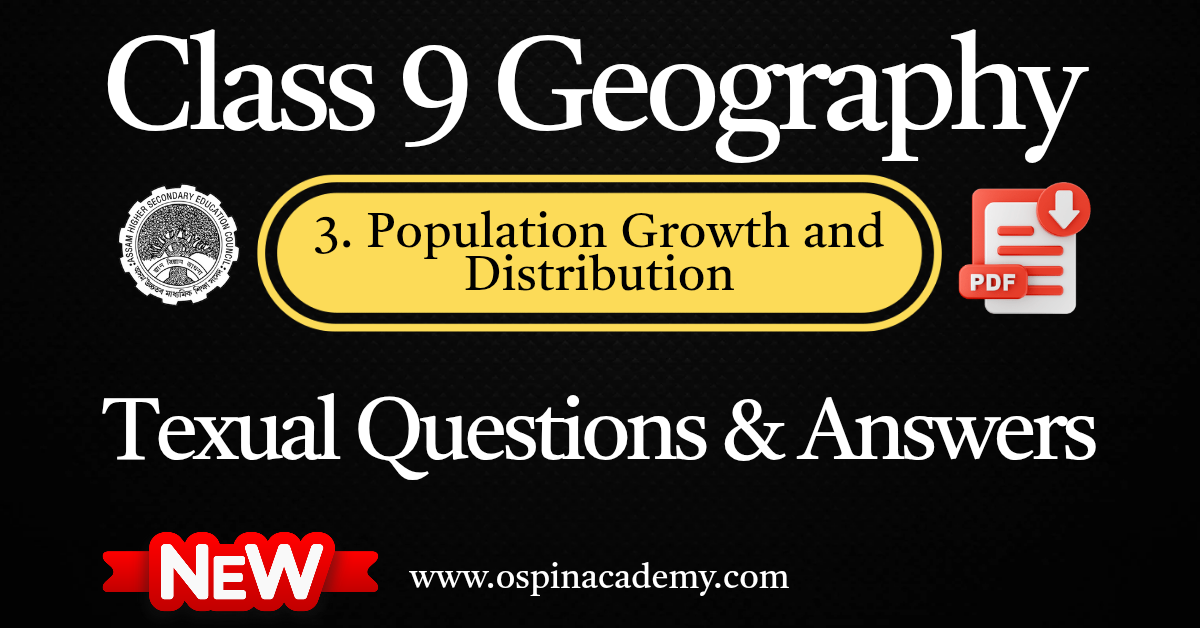Class 9 Geography Chapter 3 – Population Growth and Distribution Complete Solutions | Assam Board (ASSEB) | Latest Syllabus | English Medium
Class 9 Geography Chapter 3 – Population Growth and Distribution Complete Solutions (Assam Board – ASSEB – English Medium)
This chapter covers critical concepts related to the growth and distribution of the human population worldwide. Students will understand factors influencing population growth, demographic transition, and patterns of population distribution. The solutions provided help students grasp key ideas and prepare for examinations effectively.
✅ What you will learn:
- Concept of population growth and its types
- Factors affecting population growth
- Population distribution patterns globally and regionally
- Demographic Transition Model and its stages
- Implications of population growth on resources and development
🎯 Why choose Ospin Academy?
- Complete solutions for all questions from the latest Assam Board (ASSEB) syllabus
- Clear and detailed English medium explanations
- Perfect resource for exam preparation with practice questions
- Study material designed specifically for Class 9 Geography students
- Aligned strictly with the latest syllabus requirements
Class 9 Geography Elective English Medium | Latest Syllabus Chapter-wise Solutions PDF
Limited Time Offer!
(For Class 9 Geography Elective, English Medium)
Prepare thoroughly for Class 9 Geography Elective with this chapter-wise solutions PDF.
Includes complete, clear, and exam-focused textual solutions as per the latest syllabus.
Ideal for self-study, homework help, and last-minute revision.
Chapter-3
Population growth and Distribution
TEXTUAL QUESTIONS AND ANSWERS
EXERCISE:
1. Write about the trend of population growth in the world. Why and during which period was the population growth rate high?
Answer: In the early stages of human settlement on earth, the global population size was very small. Around ten thousand years ago, or about 8000 B.C., the world population is estimated to have been about 8 million. The main cause of such a low population level was the frequent occurrence of famines and epidemics, as humans lacked the means to control them. However, with the advent of settled agriculture, the food supply improved and population began to grow. Consequently, by the beginning of the Christian era, the world’s population had reached about 200 million.
During the medieval and early modern periods, the population continued to rise due to the spread of agriculture, growing health awareness, improvement in living standards, and the development of better medicines. By the early 19th century (around 1808), the world’s population had crossed 1 billion (1000 million). In the next 200 years (1808–2008), it increased sevenfold, reaching nearly 7 billion by 2011.
A particularly rapid population increase was recorded between 1950 and 2000. During this 50-year span, the world population rose from 250 crores in 1950 to 600 crores in 2000—an increase of 350 crores in half a century, compared to just 150 crores in the 150 years from 1800–1950. This remarkable rise was mainly due to food security, better living conditions, and advancements in medicine and health care.
2. What is the estimate of world population? State the major reasons of spatial variation in population growth.
Answer: According to the United Nations, the world’s population reached the 7 billion mark on 31st October 2011. If the current growth trend continues, it is expected to exceed 8 billion by 2025 and reach about 9.5 billion by 2050. One major characteristic of global population is its uneven growth across different regions and times. The main factors responsible for such spatial variation are:
(i) Improvement in standard of living: As living standards rise, people tend to have fewer children because higher income families prefer smaller, better-managed households.
(ii) Agricultural development: Greater food availability and better-quality grains reduce child mortality, resulting in higher population growth.
(iii) Medical advancement: Progress in healthcare and medicine has increased life expectancy and reduced death rates, as people are now more aware and take preventive health measures.
(iv) Economic development: Developed nations such as the USA, UK, and Canada show slower population growth due to high economic standards, whereas low economic development leads to higher birth rates in poorer regions.
(v) Improvement in education: Higher literacy rates, as seen in Kerala, are linked with reduced population growth because education promotes awareness of family planning.
3. Give a picture of regional variation in population growth in present time in the world.
Answer: Population growth and its rate vary significantly between developed and developing countries. Between 1750 and 1950, the average annual growth rate in developed countries was around 0.8%, while in developing nations it was about 0.5%. However, from 1950 to 1970, the growth rate changed—developed nations recorded about 1.1%, while developing ones rose to 2.2%.
At the continental level, differences were also evident. From 1750–1850, Africa’s growth rate was just 0.05% compared to Europe’s 0.53%. By 1950–2000, Africa’s rate rose sharply to 2.55%, whereas Europe’s fell to 0.6%. Central and South America witnessed a rapid growth of 2.6% during this period, while Asia recorded the highest population growth overall—its population rising from 502 million to 3680 million. In contrast, North America’s population grew from only 2 million to 316 million in the same span.
4. Write about population distribution in the world and state the major factors of unevenness in the distribution.
Answer: A major feature of the global population is its unequal size and distribution across continents. As per UN estimates, the world population in 2010 was about 697 crores. Out of this, Asia accounted for around 61% (425 crores), Africa 14.7% (102 crores), Europe 10.5% (73 crores), North America 5% (35 crores), South and Central America 8.3% (58 crores), and Oceania only 0.5% (3.6 crores).
In 2010, about 18.4% of the world’s people lived in developed countries like the USA, UK, and Canada, while 81.6% lived in developing and underdeveloped nations. China alone housed about 20% of the world’s population, followed by India with roughly 17%.
This uneven distribution of people is primarily influenced by the following factors:
(i) Climate
(ii) Topography
(iii) Soil quality
(iv) Availability of power and mineral resources
(v) Transportation facilities
(vi) Socio-economic conditions
5. Discuss with examples about the role of topography and climate in population distribution.
Ans.
(i) Topography: The physical nature of land plays a major role in population distribution. People prefer to live on plains rather than hilly regions because agriculture and transport are easier in flat areas. In contrast, mountains make movement, trade, and industry difficult, leading to sparse population. For instance, Himalayan states such as Arunachal Pradesh, Jammu & Kashmir, and Himachal Pradesh are less populated than the plains of Uttar Pradesh, Bihar, Assam, and West Bengal.
(ii) Climate: Climate elements such as temperature, rainfall, and humidity greatly affect human settlement. Agriculture, which sustains life, requires suitable temperature and adequate rainfall. Hence, extreme environments like the Arctic (Tundra), deserts, and hot equatorial forests are sparsely inhabited. The dense population of South and South-East Asia is due to favourable temperatures and sufficient rainfall in these regions.
6. Stating the major densely populated regions of the world, briefly discuss their geographical characteristics.
Answer: The most densely populated regions in the world are:
(i) Asia
(ii) South Asia
(iii) Western Europe
(iv) North-eastern coastal plains of the USA
The geographical features responsible for their high population density are:
(i) Extensive plains suitable for farming, industries, and easy settlement.
(ii) Adequate rainfall ensuring agricultural prosperity.
(iii) Moderate temperatures favourable for living and working.
(iv) Fertile soil and coastal location aiding agriculture and trade.
(v) Well-developed transportation and communication networks including roadways, airways, waterways, and railways.
7. What are the major thinly populated regions of the world? What are the main reasons behind thin population in those areas?
Answer: The main sparsely populated regions of the world are:
(i) Tundra regions of North America and Europe
(ii) Hot deserts like the Sahara, Kalahari, Gobi, and Thar
(iii) Equatorial forest zones
(iv) High mountain systems such as the Himalayas, Rockies, and Andes
The key reasons for low population in these regions include:
(i) Infertile soil
(ii) Extremely hot or cold climate
(iii) Very low or excessive rainfall
(iv) Rugged terrain
(v) Poor transport and communication links
(vi) Low economic development
(vii) Dense forest cover
8. What do you mean by “human migration”? What are its major types?
Answer: Human migration refers to the movement of individuals or groups from their place of residence to another location for a considerable period of time, usually in search of better opportunities.
The main types of migration are:
(a) Based on distance: Short-distance, long-distance, internal, and international migration.
(b) Based on time: Short-term, long-term, seasonal, permanent, and temporary migration.
(c) Based on reasons: Economic, social, political, and religious migration.
9. Write briefly why ‘human migration’ takes place.
Answer: The primary reasons behind human migration are:
(i) Unemployment or lack of job opportunities
(ii) Poor educational facilities
(iii) Low economic growth
(iv) Religious persecution
(v) Political instability and disorder
(vi) Social or communal violence
(vii) Partition of countries
(viii) Wars (internal or external)
(ix) Recurring natural disasters
10. State the push and pull factors of human migration.
Ans.
[I] Push factors: These are conditions that compel people to move away from their native places.
Main push factors include:
(i) Lack of employment
(ii) Poor educational facilities
(iii) Low economic growth
(iv) Communal unrest
(v) Political instability
(vi) Harsh climatic conditions
(vii) Frequent natural disasters
[II] Pull factors: These attract people to settle in new regions.
Main pull factors include:
(i) Better employment prospects
(ii) Good educational institutions
(iii) Political peace and stability
(iv) Favourable climate
(v) High economic growth
(vi) Social harmony
(vii) Efficient transport and communication networks
11. What do you mean by international migration? Write briefly about the causes and consequences of the international migrations with examples.
Answer: Migration from one country to another for education, employment, or permanent settlement is termed international migration.
The main causes include:
(i) Educational purposes
(ii) Better job prospects
(iii) Economic opportunities
(iv) Religious persecution
(v) Political instability
(vi) Social or communal violence
(vii) Partition of countries
(viii) Wars (internal or external)
(ix) Natural calamities
Examples: The partition of India in 1947 displaced around 15–20 million people. The creation of Israel in 1948 forced about 2 million Palestinians to migrate to Arab nations. The 1950 Chinese invasion of Tibet led many Tibetans to flee to India. Before the 1971 Bangladesh War, thousands of Muslims migrated to Assam and West Bengal from East Pakistan. Both the World Wars also resulted in large-scale population displacements across Europe and Asia.
12. Write short notes:
(a) Population explosion:
The sudden and rapid rise in the world’s population is called a population explosion. Between 1950 and 2000, the world’s population grew sharply from 250 crores to 600 crores—an increase of 350 crores in just 50 years, compared to 150 crores in the 150 years between 1800 and 1950. The main reasons were improved food supply, higher living standards, and advancements in medical science and health services.
(b) Density of population:
Population density refers to the number of people living per square kilometre. It is calculated by dividing the total population of a region by its total area. In 2010, the world’s average population density was around 47 persons per sq. km. The density varies greatly across countries—for example, Bangladesh had about 1,046 persons per sq. km, while India’s density stood at around 378 persons per sq. km.
(c) Internal migration:
Migration that occurs within a country is called internal or intranational migration. It may involve movement from one state, district, or locality to another. It can take the following forms:
(i) Village to town
(ii) Town to village
(iii) Town to town
(iv) Village to village
Its major causes include search for better education, job opportunities, political and religious issues, natural calamities, and economic development.
(d) International migration:
When people move from one nation to another for purposes such as education, employment, or settlement, it is known as international migration. The largest such movement occurred between the 17th and mid-19th centuries, when over 10 crore Europeans migrated to countries like the USA, Australia, New Zealand, and South Africa. Major causes include job opportunities, peaceful conditions, economic growth, religious and political persecution, wars, and natural calamities.
(e) Pull factors of human migration:
Pull factors are the conditions or advantages that attract people to move and settle in a new place. These factors make a destination appealing by offering better living opportunities.
The main pull factors include:
(i) Availability of good employment opportunities
(ii) Access to quality educational facilities
(iii) Political stability and peace
(iv) Favourable climatic conditions
(v) High level of economic development
(vi) Social harmony and safety
(vii) Well-developed transport and communication systems
(f) Push factors of human migration:
Push factors are the adverse conditions that force people to leave their place of residence and migrate to other regions. These act as “repelling” influences in migration.
The main push factors are:
(i) Lack of employment opportunities
(ii) Poor educational and health facilities
(iii) Low level of economic development
(iv) Political instability and disorder
(v) Social or communal conflicts
(vi) Unfavourable climatic conditions
(vii) Frequent natural disasters such as floods, droughts, and earthquakes
(g) Bangladesh–India population migration:
A significant population movement occurred from East Pakistan to Assam during the late 1960s and early 1970s, following the partition of India (1947) and Pakistan (1971). Even after Bangladesh was formed, migration into India continued due to displacement during the 1971 war. Contributing factors included availability of agricultural land and better economic prospects in Assam. The porous border made migration easy, leading to a major demographic, social, and economic impact on the state.
13. State the reasons behind variation in population density in your locality.
Answer: The variation in population density in my locality is influenced by factors such as topography, climate, soil fertility, transport and communication facilities, economic activities, and availability of employment opportunities. Areas with fertile plains, good transport links, and developed markets have dense population, whereas hilly, flood-prone, or economically backward regions have sparse settlement.
14. Choose the correct answer:
(a) In which year world had a population of about 1 billion?
(i) In 1950
(ii) In 1808
(iii) In 1908
(iv) In 1008
Answer: (ii) In 1808
(b) What is the main reason of world population growth?
(i) Increase in birth rate
(ii) Decrease in death rate
(iii) Decrease in death rate compared to birth rate
(iv) Migration
Ans.(i) Increase in birth rate
(c) Which is the least populous continent in the world?
(i) Africa
(ii) Oceania
(iii) Europe
(iv) South America
Answer: (ii) Oceania
(d) Among the following countries which one has the highest population density?
(i) Japan
(iii) Bangladesh
(ii) India
(iv) Indonesia
Answer: (iii) Bangladesh
15. With guidance of teacher collect data about number of births and deaths from at least 30 houses in your village or hamlet and prepare a table. Find out the main factors of population distribution. State the reasons of uneven distribution of population in your area.
Answer: Self Task
Class 9 Geography Chapter 3 – Frequently Asked Questions
Get Free NCERT PDFs
If you want to download free PDFs of any chapter, click the link below and join our WhatsApp group:




